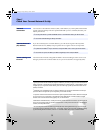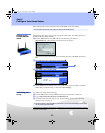
5
Step 1
Check Your Current Network Set Up
Network
connection
You must have a broadband connection (DSL, cable modem, etc.) with uplink and downlink
speeds of at least 300 kbps. The more uplink bandwidth you have available, the better your
NetAV performance.
Internet Protocol
(IP) Address
If you do not already have a fixed IP address
1
, you will need to register with a Dynamic
Domain Name Service (DDNS)
2
. Step 2 explains how to register with one such provider.
Router setting and
Firewall
Your home router must be configured for DMZ
4
or Port Forwarding
5
to allow secure access
through your firewall. You must enable use of a port for LocationFree TV (typically 5021).
✍ For best performance a premium bandwidth service is recommended. Contact your ISP for details.
✍ You cannot use NetAV through a dial-up connection.
✍ A public fixed IP address
3
may be used in lieu of a dynamic DNS service. Contact your ISP for details.
✍ You cannot use a private IP address (an address assigned by a home router) for NetAV.
1
Typically your Internet Service Provider (ISP) assigns an IP address to you when you sign up for service. However, this IP
address is “dynamic,” meaning that it may change. Most ISPs offer, for a monthly premium, a “fixed IP address” that is
assigned only to you. If you have a fixed IP address, you do not need to sign up with a Dynamic Domain Name Service
(DDNS) to use NetAV.
2
A DDNS lets you tie a Host/Domain name to a dynamic IP address. If you do not have a Host/Domain name and your
dynamic IP address is changed while you are using NetAV, your connection will drop.
3
Every device connected to the Internet must have either a public or private IP address. Public IP addresses are assigned
to a home router or to a PC when either is connected directly to the global Internet. A Private IP address is assigned
between a home router and another device, typically a PC, on a home network.
4
DMZ stands for “demilitarized zone,” a military term meaning a buffer area between two enemies. On some routers the
term is used to represent a buffer area (outside a firewall) between a trusted private network and an un-trusted external
network, such as the public Internet.
5
Port forwarding offers a means of transferring unsecured data from TCP/IP applications through a secure connection.
The transfer of unsecured data takes place by means of “tunneling” through a secure connection established by setting
up port forwarding between two devices, in this case the LocationFree Base Station and the LocationFree Monitor.
LFX1.fm Page 5 Friday, February 4, 2005 7:04 PM
















